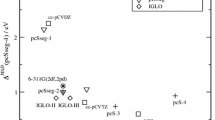Abstract
A method to calculate the Stark shifts and splittings in noble gases is described and results for neon I are presented. The energy values in a static homogeneous electric field are found by diagonalizing the energy matrix numerically. This matrix consists of the energy values of the free atom taken from experiment and of off-diagonal matrix elements of the electric field operator. The latter are computed using wave functions consisting of a radial function of the excited electron found by numerical integration, and of a two-particle (core+electron) spin-orbital part represented by rigorousjl coupling. As an example, the splitting of the levels 6s to 6p is shown and is explained in terms of atomic level positions, the relative size of matrix elements and of selection rules. A nomenclature for the high field Stark effect is developed in accord with group theory.
Similar content being viewed by others
References
Bethe, H.: Quantenmechanik der Ein- und Zweielektronenprobleme. In: Handbuch der Physik XXIV/1, Geiger, H., Scheel, K. (eds.) Berlin: Springer 1933
Ryde, N.: Atoms and molecules in electric fields. Stockholm: Almqvist and Wiksell 1976
Harmin, D.A.: Comm. At. Mol. Phys.15, 281 (1985)
Bergeman, T.: Numeric calculations of the stark effect in neutral hydrogen. In: H-Workshop-Session, Los Alamos, November 1981
Windholz, L.: Phys. Scr.21, 67 (1980)
Jäger, H., Windholz, L.: Phys. Scr.29, 344 (1984)
Ziegelbecker, R.Ch.: Berechnung des Starkeffekts von Edelgasatomen unter Annahme reiner jl-Kopplung am Beispiel des Ne I. Dissertation, Technische Universität Graz 1986
Ziegelbecker, R.Ch., Jäger, H., Windholz, L., Schnizer, B.: Tables related to a calculation of the stark effect of neon I. Report of the Institut für Experimentalphysik der Technischen Universität Graz, Graz 1987
Ziegelbecker, R.Ch., Jäger, H., Windholz, L.: Phys. Scr. (to be published)
Moore, Ch.E.: Atomic Energy Levels I. In: Circular of the National Bureau of Standards 467. U.S. Government Printing Office, Washington D.C. 1949
Racah, G.: Phys. Rev.61, 537 (1942)
Froese-Fischer, Ch.: The Hartree-Fock method for atoms. New York: Wiley 1977
Feneuille, S., Klapisch, M., Koenig, E., Liberman, S.: Physica48, 571 (1970)
Gordon, W.: Ann. Phys.2, 1031 (1929)
Van der Waerden, B.L.: Group theory and quantum mechanics. In: Die Grundlehren der mathematischen Wissenschaften 214. Eckmann, B., Moser, J.K., Van der Waerden, J.K. (eds.) Berlin, Heidelberg, New York: Springer 1977
Edmonds, A.R.: Angular momentum in quantum mechanics. In: Investigations in physics 4. Wigner, E., Hofstadter, R. (eds.) Princeton: Princeton University Press 1957
Author information
Authors and Affiliations
Rights and permissions
About this article
Cite this article
Ziegelbecker, R.C., Schnizer, B. Calculation of the Stark effect of neon I usingjl coupled wave functions. Z Phys D - Atoms, Molecules and Clusters 6, 327–335 (1987). https://doi.org/10.1007/BF01437059
Received:
Issue Date:
DOI: https://doi.org/10.1007/BF01437059




